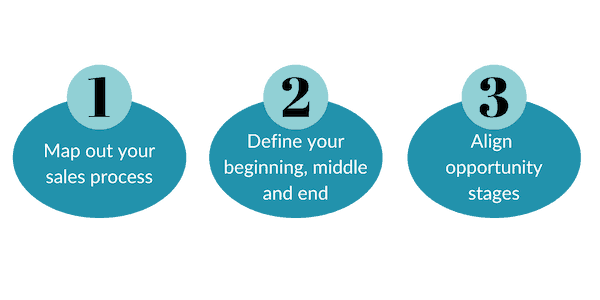Salesforce
3 July 2019

You may have seen the marketing material and sales literature declaring that introducing Salesforce as your CRM will increase sales growth by up to 10% (source: salesforce.com). In my experience, this can absolutely be a reality. What many businesses signing up for the application forget though, is that simply installing Salesforce is not enough. To get the best out of the system, it’s important to also invest in onboarding and sales process. Do this well and you’ll never regret making the leap. Fail to manage the change effectively and you’re unlikely to get the return on investment you’d been banking on.
Proper implementation isn’t as daunting as it sounds though. And even if you’ve already been up and running with Salesforce for a while, there is one key area you can work on to bring about a massive improvement in your sales operation: aligning your sales process. Here just 3 simple steps to getting this right.

Without a clear sales process, tailored to your product and how you can most successfully sell it, there will be little or no consistency amongst the sales reps’ approach. You’re therefore faced with pipeline data that is undefined in terms of its relevance to the sales cycle and forecast. Whilst one rep may report a prospect as being part of his funnel only once he has a proposal on the table, another begins tracking much sooner, adding a prospect to the pipeline as soon as they have identified the customer’s needs. Can you see the dilemma? Reviewing the sales funnel of these two reps would be like comparing apples with pears.
For most sales organisations, the sales cycle will be defined by key milestones – be that the discovery of the customer need or proposal creation. Defining these steps and having a common language associated to your sales cycle will allow you to become more prescriptive around how this data is documented in your CRM. Without that you’ll soon witness sales teams using the CRM in very different ways. Some will enter details of a possible deal early on, whilst others will show very little engagement. In some organisations I’ve worked with, their very expensive Salesforce set up was little more than an order processing system. No sales activity was ever recorded. A rep would only enter anything into the system once they were ready to make a sale.
If this sounds familiar, then you need to fix this quickly! Strong pipelining begins with how you record your sales process. Without consistent entry of potential sales, you will fail to get the visibility you need to make forecasting as simple as possible. You’ll also be missing out on some key insight into the health of your business.
For the rep, documenting their pipeline at the beginning of the sales cycle will help with efficiency and organisation. Salespeople that follow this approach typically close 10% more business than their (less organised) peers. I’ve seen even the most successful reps, with their own tried and tested methods of organising their day, benefited from shifting to a more structured pipeline approach.
Often the most difficult element when mapping out the sales cycle is determining at which point it begins. Getting this right is key to establishing a workable pipeline. How you define the early stages of a sale will vary, depending on the nature of the business – lead in times, the volume of sales and the market opportunity. If you’re selling high volume products, to a wide consumer group, your sales cycle may begin only at the point that a price is quoted. Including a prospect in your pipeline before that time would make little sense if you know that your market is vast and the differentiating factor between a true opportunity needs to be clearer than this. But if you’re a software company, with a small target market and a long sales cycle, your opportunity will most likely begin when you’ve identified a decision maker and know this person should be doing business with you.
Having this clarity, will give you consistency around how your teams define their pipeline of business, from the very outset of the sales process. Be mindful to involve your reps when building these definitions. They know the market best and are far more likely to adopt the sales process agreed if they played a part in creating it. One of the first rules of change management is to consult those that are impacted. Follow that principle and you’ll have a much easier time implementing change and, more importantly, ensuring it sticks.
If you’re using Salesforce, you can easily define your sales process with sales stages under the opportunity. Make it part of the rep’s workflow to keep these updated and make sure they understand how the stages will be reflected in the pipeline. Below an example of what that might look like:
This example is taken from a media business, where the sale can vary massively, both in terms of contract size and lead time. However, for the most part, their potential client base is easy to define, and the sales cycle follows these steps.
Map out your sales process and insist on the proper use of opportunity stages and you’ll very quickly have improved visibility of your business pipeline, giving you the tools to accelerate sales by focusing on areas that need improvement. Your investment and effort will be rewarded!